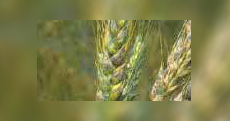Septoria Leaf And Glume Blotch
As a Threat to Wheat Production in Kenya
Introduction
Wheat is the second most important cereal grain in Kenya after maize. Wheat farming in Kenya is largely done for commercial purposes on a large-scale. Wheat production faces a range of challenges; unreliable rainfall, Insect pests, weeds and diseases. Septoria tritici Blotch (STB); one of the major economically important fungal diseases in wheat poses a serious and persistent challenge to wheat grown globally. This threat has triggered an intensive research effort to evaluate current disease control practices and to look for novel control strategies. Septoria leaf and glume blotch attacks the leaves and heads of wheat.
Symptoms of Septoria Tritici Blotch (STB)
Brown necrotic lesions with black specks (bearing spores) on the leaves (Figure 1) and heads (Figure 2). Severe infection of leaf blotch or glume blotch may result in light shrivelled kernels.


Environmental factors and their impact on the importance of Septoria tritici as a wheat pathogen
The factors that alter the chance of an STB epidemic are quite well understood. Septoria tritici requires a moist leaf surface for successful infection and is spread through-out the crop canopy via rain splash, the frequency of either very wet days (>10mm rainfall) or consecutive wet days (three days with at least 1mm rain) during the early growth of the wheat crop has been found to be of major importance in predicting outbreaks. Similarly, the frequency of weather fluctuations is important, with temperatures below −20C in the early stages of growth reducing the risk of STB.
Control
- Plant disease free seed.
- Crop rotation with crops like canola and beans.
- Foliar fungicides can also prevent infection if applied early
Indeed, the timing of fungicide application is somewhat problematic, as it is difficult to match it confidently with disease progression. Fungicides sprayed at disease onset are effective for approximately seven of the 14–28 day latent period. Thus, whilst the leaves remain asymptomatic and the farmer considers that disease has been eradicated, it is possible that in fact the fungus proliferates. Best practice therefore requires that fungicide be sprayed early, before disease appears, to protect developing stem leaves, and again at ear emergence, to protect the flag and upper leaves. However, if lesions begin to show on the leaves, STB has taken hold and fungicide application will be of limited utility. Few curative fungicides chemistries that prevent pathogen colonization of host tissues are available.
R&D companies create chemistry for a sustainable future. Their scientists consistently work to come up with innovative branded crop protection solutions that enable our wheat farmers to manage various insect pests, diseases and weeds. This eventually aid in ensuring that they derive benefits from farming. Their premium fungicides have been successfully used by wheat farmers in Kenya and East Africa at large to manage fungal diseases in wheat. Their effects on the crop have consistently guaranteed them improved yields.
Wheat farmers can count on partnering with them to ensure that their farming venture is assured and their improved yields guaranteed. They are also committed in ensuring that farmers and our environmental safety is taken care of by offering safe and costeffective crop solutions.